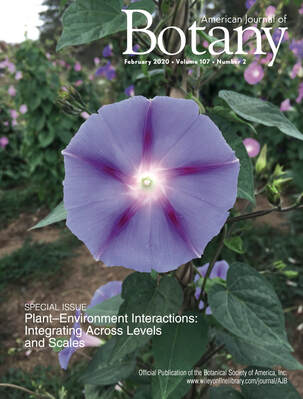Dissertation Research
|
For my dissertation, in the Baucom Lab, I looked at the evolutionary potential of an agricultural weed, the common morning glory. Baker (1974) identified a list of traits that make up an 'ideal' weed. These traits include characteristics such as rapid growth rate, high seed output, and being tolerant and plastic. Despite his work being heavily cited there has been little to no work that have examined the microevolutionary potential of these traits. Using the principles of quantitative genetics in both the field and green house I have examined the evolvability of weediness in the common morning glory. My dissertation encompasses three major studies: first, I investigate genetic variation of key weediness traits. Second, I've look at the costs and benefits of tolerance to competition in the common morning glory when grown in interspecific competition with maize. And third, I combined original research and big data analysis to investigate the 'general purpose genotype', a term coined by Baker for plants that are able to tolerate a wide range of edaphic conditions.
|
"Weeds are excellent subjects for the study of adaptation and microevolution" |
Weediness Traits
Although there have been many that have cited Baker’s list of weediness traits, or those traits that exemplify the 'ideal' weed, few have considered the evolutionary potential of such traits as a group. Here I used progeny from a half/full-sib breeding design in a series of three greenhouse experiments to assess the presence of genetic variation, narrow sense heritabilities, and genetic correlations in Baker’s growth, competition, and fitness 'weediness' traits in two populations of Ipomoea purpurea.
Tolerance to Competition
Tolerance to competition has been hypothesized to reduce the negative impact of plant-plant competition on fitness. Although competitive interactions are a strong selective force, an analysis of net selection on tolerance to competition is absent in the literature. We measured fitness and putative tolerance traits using twenty paternal half-sibling families in the crop weed Ipomoea purpurea when in competition with maize in an agricultural field.
The General Purpose Genotype
The 'general purpose genotype' refers to a weed with a wide range of climatic and edaphic tolerances, a trait that is thought to lead to plant invasions. Here I combine original research with analysis of big data to assess the relationship between tolerance and fitness in Ipomoea purpurea. It is posited that plants that have the general purpose genotype should both maintain fitness in poor environments and achieve high fitness in ideal environments; however, this hypothesis remains unexamined.
|
Plant flowering time plays an important role in plant fitness and thus evolutionary processes. Soil microbial communities are diverse and have a large impact, both positive and negative, on the host plant. However, owing to few available studies, how the soil microbial community may influence the evolutionary response of plant populations is not well understood. Here we sought to uncover whether belowground microbial communities act as an agent of selection on flowering and growth traits in the common morning glory, Ipomoea purpurea.
Chaney, L., & Baucom, R. S. (2020). The soil microbial community alters patterns of selection on flowering time and fitness‐related traits in Ipomoea purpurea. American journal of botany, 107(2), 186-194. DOI: 10.1002/ajb2.1426; Analysis Code: https://github.com/lchaney/MG_Microbe; Data: https://doi.org/10.5061/dryad.p8350q3; |
Summer Drought Reduces the Growth of Invasive Tree-of-Heaven
Tree-of-heaven (Ailanthus altissima) is an invasive species in North America that is becoming widespread in the eastern part of the continent. In the drier, western interior of North America, however, the spread of tree-of-heaven appears to be limited to areas where supplemental water is available such as in urban areas or in riparian environments. To explore the effect of summer drought on tree-of-heaven seedlings and to look for genetic variation for drought tolerance among half-sibling families from Utah County, Utah. There was no genetic variation for drought tolerance observed for any of the growth parameters. These results suggest that tree-of-heaven seedlings from this part of western North America are uniformly and negatively affected by drought and may explain the relative dearth of tree-of-heaven in the interior West.


